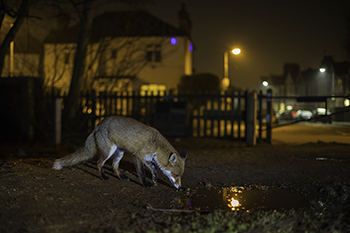Fact Sheet FS1325
The red fox (Vulpes vulpes) is a widespread, omnivorous mammal that lives in a wide range of habitats throughout New Jersey. Historically, red foxes were only found in the old growth forests of Europe and northern North America, and there is no evidence that they existed in New Jersey. Therefore, the red foxes that live throughout New Jersey today are either descendants of introduced European red foxes, or the result of an expansion of native North American populations following the large-scale conversion of forest to agriculture post-European settlement. Their intelligent and highly adaptive nature allows red foxes to exploit most natural habitats, as well as heavily urbanized landscapes, resulting in both positive and negative effects on native biodiversity.
Ecology of the Red Fox
Description

Figure 1: Typical coloration of a red fox, exhibiting the black ear tips and feet, with white tipped tail. Photo credit: Tory Kallman.
Red foxes belong to the taxonomic family Canidae, which includes foxes, wolves, coyotes, jackals, and dogs. There are three wild Canidae species that occur in the eastern United States: red fox, gray fox (Urocyon cinereoargenteus), and eastern coyote (Canis latrans). These species are often misidentified due to their similar ‘doglike’ appearance and color variations, as well as the low-light conditions of the dusk to dawn (crepuscular) hours in which they are typically seen. Red foxes are typically bright red to yellowish-red in color and always have black legs, black-tipped ears, and a white-tipped tail (Figure 1).
Red foxes are larger than grey foxes but smaller than eastern coyotes, weighing an average of 7–15 lbs. Males tend to be approximately 10% larger than females. North American red foxes can exhibit one of four coloration patterns (phases). The most common within New Jersey is the signature bright red to orange coat with a white underside. Other fur phases are more common in colder regions of North America and include black, silver, and a cross-phase in which the fox exhibits dark greyish-brown fur with a darker cross pattern across its shoulders. Red foxes have nonretractable claws much like their canid cousin, the domestic dog.
Habitat

Figure 2. A red fox in an urban park at night. Photo credit: Jamie Hall.
Though they are native to the old growth forests of Europe and North America, red foxes are now found in most habitat types, including significantly human-modified landscapes (Figure 2). In fact, red foxes are capable of dwelling in almost any setting with adequate food resources. This advantage has allowed for long range expansions across North America over the past 200+ years. Red fox home range sizes vary drastically depending on habitat type and resource availability, but they typically range from 2 to 8 square miles. Males can be territorial, particularly when resource availability is low, such as during winter months. Territorial behavior includes scent marking and using excrement to denote territory boundaries.
Diet
Red foxes are omnivorous, feeding on a wide variety of animals and plants. Their diet can vary significantly across seasons depending upon food availability. Red foxes are capable hunters of both small mammals (i.e. voles, groundhogs, rabbits) and birds. Their relatively large ears allow them to hear and capture prey hidden deep within leaf litter, thick vegetation, or even snow. In addition to live prey, red foxes also consume eggs of birds and reptiles, and they are opportunistic scavengers of human resources, such as food waste and agricultural products. When available, fruit can make up a significant portion of a fox’s diet.
Life History

Figure 3: Red fox kits exploring outside the den. Photo credit: Harry Collins.
Most red foxes are monogamous and maintain a breeding relationship for life. Where food resources are plentiful, a single male fox (dog) may maintain a larger territory and mate with multiple females (vixen). Unpaired foxes seek out a mate in mid to late fall. The breeding season in New Jersey and other temperate regions occurs during January and February. Litter size is thought to be directly correlated with the availability of food, with most litters ranging from 3 to 7 kits, which are born in early to mid-Spring.
In the spring before the vixen gives birth, the mated pair selects a den location for rearing the kits. Foxes will dig dens in loose soil or sand, often expanding burrows used by other smaller mammals. They may also burrow under fallen trees or use large tree cavities. In suburban areas, foxes commonly den under backyard porches and decks. During rearing, the vixen stays in the den and tends to the kits while the male fox gathers food and returns it to the den for his mate and offspring. Kits begin eating solid foods after being weaned from their mother’s milk between 8–10 weeks after birth. At three weeks of age, the kits can begin to walk and may emerge from the den (Figure 3). Parental care continues until the juvenile foxes reach adult size at 6–7 months of age. By September or October, the young foxes disperse to find their own home ranges. Red foxes reach sexual maturity within the end of their first year.
Benefits of Red Foxes to Nature and Society
Ecological
Red foxes can greatly enhance the ecosystems they inhabit. As highly mobile animals, red foxes act as dispersal agents for many plants. They can also regulate populations of rodents, which aids in the reduction of Lyme disease within the landscape. Rodents, like mice, can be carriers of the bacteria that cause Lyme disease. If a tick bites an infected mouse, that tick will then also be a carrier of Lyme, therefore a reduction of mice in an area can mean a reduction in Lyme disease-carrying ticks. Red foxes are also capable hunters of small mammals that are sometimes seen as pests, reducing the impact of these pests on agricultural and residential areas within the state. In addition, red foxes aid in ecological recycling (breaking down organic matter to return nutrients to the environment) by consuming carrion.
Recreational
Red foxes are a popular game species and furbearer in New Jersey. Each winter, thousands of red foxes are harvested in the fur trapping effort within New Jersey. Foxes in New Jersey are live caught using cable restraints to reduce the possibility of trapping nontarget animals. These trapping efforts not only help to regulate the red fox population, but the permit fees that trappers pay in New Jersey contribute tens of thousands of dollars to the New Jersey Department of Environmental Protection each year. Since most trappers dispatch captured furbearer species with .22 caliber rifles/revolvers, red fox recreational activities indirectly provide funds to the conservation of wildlife in New Jersey through the Pittman-Robertson Act, which imposes an excise tax on all firearms, ammunition, and arrow purchases within the United States.
Red Fox as a Nuisance Species

Figure 4. A red fox with a chick in its mouth. Photo Credit: Margaret Natka.
Because red foxes adapt so well to human-dominated landscapes, New Jersey has a prolific fox population in urban and suburban areas. In most cases, red foxes pose no threat to human health and safety and should not be disturbed. Foxes are naturally fearful and skittish around people, and they tend to stay hidden from view. However, seeing a fox during the day does not mean it is sick or acting abnormal; red foxes are opportunistic and will feed on available food items, despite the time of day. Daytime activity is most pronounced in late spring, when males are working to meet the high food demands of growing kits.
However, red foxes can become a nuisance if they have lost their fear of people, or if they are denning in close proximity to humans, such as under a porch or shed. In agricultural areas, they may prey upon domestic species such as poultry and rabbits (Figure 4). In more natural settings, red foxes can and will make use of eggs as a food resource. Fox predation can cause a negative effect on populations of ground-nesting species, such as shorebirds, gamebirds, waterfowl and turtles, many of which are listed as threatened or endangered in New Jersey.
Red Foxes and Rabies
Although it is rare in the United States, red foxes can be carriers of the rabies virus. Typical symptoms of the virus in foxes are seizures, an inability to drink water, disorientation that can cause a “zombie-like” state, and, occasionally, biting at objects and other animals. If a fox exhibiting any of these symptoms is seen, care should be taken to stay away from the animal and contact your local animal control officers, police, or DEP Hotline at 877-WARN-DEP (877-927-6337).
Managing Red Foxes in New Jersey
Non-lethal Methods
Prevent Habituation
Red foxes can become habituated (lose their fear of people) if they are fed by people or repeatedly find refuge or food resources in an area. Once a fox becomes habituated, it can become bolder and might start preying upon smaller domestic animals such as cats, small dogs, chickens, and rabbits. NEVER intentionally feed red foxes.
Property Maintenance
If there is an area where red foxes are not welcome, that area should be maintained in a way that discourages occupancy by fox prey. Brush piles, tall grasses, leaf litter, or other features preferred by small mammals should be removed. Garbage cans and bird seed containers should be secured, and pet food bowls should be brought inside at night.
Aversive Conditioning/Repellents
A fox or fox den on your property generally poses no risk and should be left alone. However, sometimes foxes can be found denning in undesirable areas such as under sheds and decks. Red foxes tend to leave an area or denning site if they are disturbed. Sensory deterrents such as music or motion-activated lights or sprinklers near a fox den may help encourage the fox to leave the site. When the fox is seen, safely scare away the animal by yelling, and looking large and intimidating. If this is done each time that a fox is encountered, the animals will eventually learn that the area is not one in which they are welcome. Wildlife control companies have reported success when using wolf urine or scent glands in attempting to keep foxes away or deterring foxes from returning to an area, but there have been no documented scientific studies proving this method. Keep in mind, if a fox is only briefly seen in an area, it may only be passing through. Aversive conditioning methods should be reserved for situations where a fox is denning in an undesirable location.
Exclusion
Stainless-steel hardware cloth can be used to prevent foxes from denning under structures, such as sheds or decks. Attach the material to the lower edge of the structure, and bury it least 12 inches into the ground, extending it 1 to 2 feet away from the structure. Exclusion practices should not be used when an existing den is active so as to avoid trapping adults or young.
If installing fencing to keep foxes outside of a larger area, be sure to have at least six feet of height across all portions of the fence. Foxes are agile climbers and jumpers and can clear lower fences. Fence material should consist of metal mesh wiring with small (2-inch x 2-inch) openings secured to metal posts driven firmly into the ground at least 18 inches deep. Chicken wire or stainless-steel hardware cloth should be buried at the base of the exterior wall of the fence to prevent foxes from burrowing beneath it. This wire or cloth can be buried a foot directly below the fence, or splayed outward from the bottom of the fence, buried shallowly under the ground for 12–18 inches. For persistent foxes, physical fences can be enhanced with electrical fencing.
Trap and Relocation
Trapping and relocating red fox in a new location is NOT a viable solution in New Jersey. Because red foxes are classified as a rabies vector species, relocations outside of the capture site are strongly discouraged. Where on-site release is infeasible, relocations must occur within a 10-mile radius of the capture site within the original township, and with the landowner’s permission. The New Jersey Division of Fish and Wildlife may approve a release at the closest or most appropriate state Wildlife Management Area on a case-by-case basis. For more information, see the New Jersey Division of Fish and Wildlife’s Policy on the Relocation of Wildlife (PDF).
Lethal Methods
To reduce the negative impacts that their presence can have on other wildlife populations, managers throughout the state have developed different strategies. Within coastal areas that support beach-nesting shorebird breeding colonies, foxes must be strictly managed to protect the remaining birds’ productivity. Strategies like lethal trapping, collapsing fox dens, and enclosing bird nests in fox-proof fencing have all been used with some success. Other less direct management strategies, such as fining the public for feeding red foxes and reducing the amount of available food waste resources, are effective ways to reduce the negative ecological impacts of red foxes. In other areas of the state, especially those of agricultural importance, trapping and fencing have also proved to be effective strategies for controlling red fox populations and impacts. The New Jersey Department of Environmental Protection allows for the killing of foxes found to be destroying agricultural products by the landowners or employees/lessees of the owners of the farmland. Any killing of foxes outside of these specific parameters requires proper permitting. We recommend calling a professional wildlife control company if you decide to use lethal methods on a problematic fox.
If you encounter a fox exhibiting unusual behavior such as unprovoked aggression, paralysis, lack of coordination, or friendly behavior, contact your local animal control officers, police, or DEP Hotline at 877-WARN-DEP (877-927-6337).
References
September 2020
Copyright © 2024 Rutgers, The State University of New Jersey. All rights reserved.
For more information: njaes.rutgers.edu.
Cooperating Agencies: Rutgers, The State University of New Jersey, U.S. Department of Agriculture, and Boards of County Commissioners. Rutgers Cooperative Extension, a unit of the Rutgers New Jersey Agricultural Experiment Station, is an equal opportunity program provider and employer.

